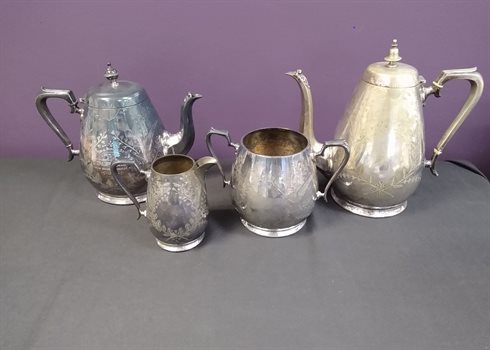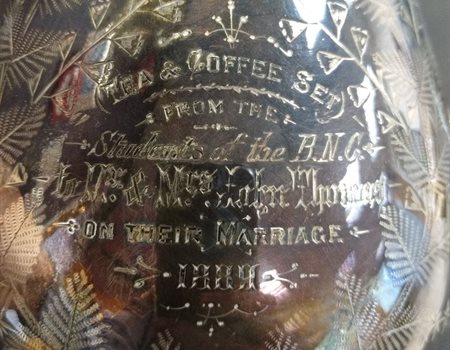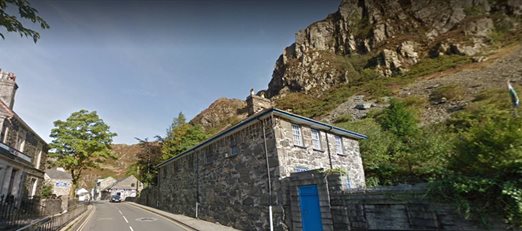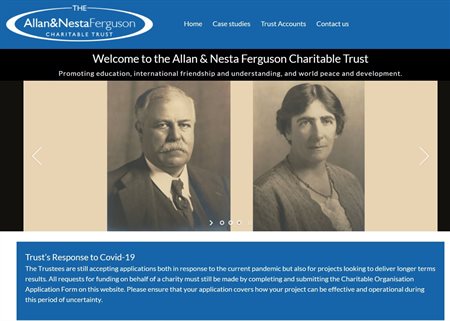In July - Aug 2021 Brunel University Archives, the home of the BFSS Archives, moved into the main university library in the heart of campus. This is a fantastic opportunity to raise our profile at Brunel. It also means that we are looking closely at our holdings, and whether we are the best place for them. It is often assumed that archivists are a bit like Gollum and the ring, and are loathe to give up anything, but actually we believe that archives should be housed by the repository that is the best fit for them, and where they will be most used. Also, Brunel University Archives is not a museum. We are unable to put artefacts on display, and usually they have no research value in themselves. Therefore, with full agreement from the BFSS, some archives and artefacts were deaccessioned from Brunel University Archives and carefully rehomed, in preparation for the move.
One of these items is a silver tea and coffee service, which was presented to John and Catherine Thomas by the students of Bangor Normal College on the occasion of their marriage in 1889.


With no paperwork for how this set came to be in the archives, I set about trying to find out who John and Catherine were.
In 1889, the date inscribed on the silverware, John Thomas was the Mathematics tutor at Bangor Normal College (founded with support from the BFSS) in North Wales. Catherine was the college matron. John seems to have been extremely well-thought of by his students (and they generally had a soft-spot for college matrons too), which explains the wonderful wedding gift of the silver service.
‘Whilst appreciating his ability and attainments and culture, we especially set a high value upon his … general kindness with which, during the thirty-six years of his connection with the College, he ever devoted to its service. He co-operated in the happiest manner with his colleagues and left upon all the students the happiest impressions…Although he was of rather forbidding appearance, his even disposition won for him the admiration of generations of students. It is worthy of note that in the many accounts of their college days written by former students we have failed to find a single adverse comment on “Old Factors,” as he was fondly called”.
[Bangor Normal College’s centenary booklet of 1958]
John’s connection to the BFSS however goes back to his childhood. Born in 1834, he was a pupil at Blaenau Ffestiniog British School.

Blaenau Ffestiniog British School. 39 A470 - Google Maps
I am very familiar with this area of North Wales. The former British School is the building on the right of the photo, with the blue door (one at each end, for boys and girls). The school was built in 1846. This is slate-mining country, and a steam railway, built to transport the slate from the quarries, still runs behind the row of buildings on the left of the photo. In the 20th century the former school became a drill hall, and its last use was as a Masonic Lodge.
John was also a pupil-teacher (teaching assistant) there from approximately the ages of 14 to 18. He then moved to London in 1854 to train as a teacher at the BFSS’s Borough Road College. Once qualified, he returned to Wales and taught at Llan Ffestiniog British School for two years, before returning to Blaenau Ffestiniog British School as headmaster. After a few years teaching he went to Bala College to study for an external degree of the University of London, graduating in Mathematics in 1863. In January 1864 John became Mathematics tutor at Bangor Normal College, and became vice-principal in 1891. He retired due to failing eyesight in 1899, and died in February 1901. Students, at their own request, carried his coffin to the funeral. (Educational Record XV June 1901 pp 592-3).
Catherine, nee Roberts, was the daughter of a local farmer.

She was twenty years John’s junior. The couple had three children; two daughters, Nesta and Idwen, and a son, Meirion, who was only six years old when John died in 1901. Nesta gained a BSc in Botany, one of the first female students to graduate from the University of London. Idwen attended the Royal College of Music in London, and Meirion gained an MA from Cambridge and became a Professor in Botany at Newcastle, and a Fellow of the Royal Society.
After John’s death Catherine took in student lodgers to supplement her income, and both sisters married students. Nesta married Allan Ferguson (PhD Physics). Their son John Ferguson was the founding Dean of the Open University, and Chair of the BFSS in the 1970s - 80s. He and his wife also founded a charity, the Allan and Nesta Ferguson Charitable Trust.

Idwen married Henry Banister, who became a lecturer in Psychology at Cambridge. Their son, Stephen Michael Banister, cousin of John Ferguson, was Secretary of the BFSS from 1978 to 1996.
So we have not one, but two possible paths for the silver service getting into the BFSS archives! Having also traced descendants (also academics), of John Ferguson and Stephen Banister, the silver tea service will be returned to the family.
This story of John and Catherine Thomas and their descendants is a perfect example of what the BFSS achieves through educational opportunity for all. British schools were often the first schools in the village or area. Blaenau Ffestiniog is remote, even today. If a child did not live close enough to a school to walk to it, quite simply, they would not get an education. The BFSS had six schools in the area around Blaenau Ffestiniog, one specifically called Festiniog [sic] Slate Quarries, built in 1845 with space for over 700 boys and girls.
The opportunity for education and social mobility the BFSS offered was huge - a serious matter, given that the sole industry in the area was slate mining, and the life expectancy of a Welsh quarryman was only 47 years. In this case, attendance at a British school by a boy in a remote slate-mining village in the 1840s led to his son, daughters, grandchildren and great-grandchildren all gaining degrees, and several becoming professors.
In the 19th century there were approximately 4000 British schools in England and Wales. How many families had the lives of their future generations changed through the chance to attend a British School?